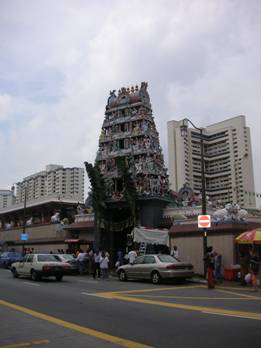|
Singapore/Science Connection
Al Albano
Letters from Singapore: 26 August | 3 October | 4 November
4 November 2005
There was considerable buzz in the Singaporean press a few weeks ago when it was announced that Warwick University (UK) decided to withdraw from negotiations to build a campus in Singapore .
Had Warwick decided otherwise, it would have become the second foreign university to build a comprehensive university campus here. The first is the University of New South Wales ( Australia ) which is scheduled to open its "UNSW Asia" campus in two years. The first group of 600 undergraduates is to be admitted in February, 2007, and by 2015, the new university is expected to have an undergraduate and graduate student body of some 15,000, of whom 70% are to come from overseas.
There are other more specialized campuses of foreign universities here. Johns Hopkins School of Medicine runs a research and teaching hospital offering programs in such areas as Biomedical Engineering, Clinical Practice, and Molecular and Cellular Immunology. The University of Chicago Graduate School of Business has an Executive MBA program. While it does not have a local campus, Penn's Wharton School of Business was greatly involved in the organization and the initial operation of Singapore Management University (SMU). Formal research collaboration programs exist between Wharton and SMU as well as between Wharton and the National University of Singapore (NUS).
All this seems to be part of an effort, greatly encouraged if not initiated by the government, to make Singapore an "educational hub" for the region if not beyond. In addition to encouraging foreign universities to establish campuses here, it also includes establishing student exchange programs with universities all over the world and recruiting students from neighboring countries. The latter effort is much aided by generous scholarships.
There are currently over two hundred student exchange programs involving foreign universities and each of the two older public universities, NUS and Nanyang Technological University (NTU). There are over a hundred involving SMU, a relative newcomer at five years old. These exchange programs typically involve accepting each other's students on something like junior semester or junior year abroad programs.
Singapore 's attractiveness to international students is quite obvious - a safe and comfortable lifestyle, instruction in English, and rigorous academic programs. For students from the region, fluency in English and a sound academic background will help when they seek employment either in their home countries or in multinational corporations. For undergraduates, these also provide a sound stepping-stone to graduate and professional programs here and abroad.
For non-Asian students, Singapore is " Asia light." It provides an easy introduction to the cultures, the traditions, the colors, the sounds, and the foods of Asia in a clean, orderly, and English-speaking environment. And it is a short hop to the rest of Asia .
As for the academics, for whatever it's worth, in its most recent ranking of 200 universities worldwide, the Times of London puts NUS at 22 d and NTU at 48 th (the top five in this list are Harvard, MIT, Cambridge, Oxford and Stanford). The list is an
|
|
Mariamman temple, Singapore. |
Firewalker in Mariamman temple. |
international version of the notorious US News and World Report list, but with a lot more weight placed on reputation and the numbers of international faculty members and students.
The sticking point in the Warwick decision seems to have been a perception that there is insufficient academic freedom in Singapore. The Straits Times , the main local paper, reports that Warwick had asked for guarantees that its faculty and students be exempted from "strict laws on freedom of assembly, speech and the press." This did not come to pass.
The Vice-Chancellor of UNSW is of the opinion that the Warwick perception may be based on "the Singapore of 15 or 20 years ago, not the Singapore now." Well, maybe not quite 15 years ago. In 1994, Christopher Lingle, an American who was then a Lecturer at NUS, had to leave the country in a hurry after he was charged with contempt of court. He had written a controversial article on the Singaporean judiciary in an international newspaper. He was found guilty in absentia and fined a considerable amount of money. Any discussion of academic freedom here resurrects the Lingle case.
Academics and academic administrators interviewed by the Straits Times in the wake of the Warwick decision say that teaching, research and publication in academic journals are unfettered. Publishing in the popular press, however, may still be a little different. In a list of another sort, Reporters Without Borders ranked 167 countries on the basis of "Media Freedom." Singapore came in 140 th .
PS. In the first of these letters, I had noted that students at SMU do not have access to corridors leading to faculty offices. Now, they do - from 8:30 to 5:45 .
<-- Previous
Home
| Calendar | About
| Getting Involved
| Groups | Initiatives | Bryn Mawr Home | Serendip Home
Director: Liz McCormack -
emccorma@brynmawr.edu
| Faculty Steering Committee
| Secretary: Lisa Kolonay
© 1994-
, by Center for Science in Society, Bryn Mawr College and Serendip
Last Modified:
Wednesday, 02-May-2018 10:51:19 CDT
| 

